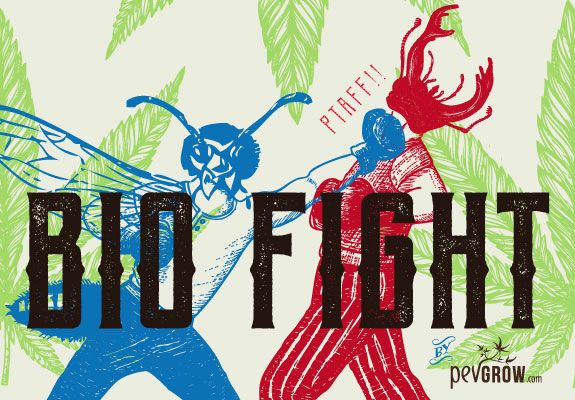

In constant struggle for the regulation of cannabis, mainly in the medicinal field.
14-07-2017 15:00:25 - Updated: 14 July, 2017
The fact that pests are increasingly resistant to chemicals, and due to increasing demand of botanical products by society that have not been treated with those chemicals have boosted the use of biological control techniques.
All these products of biological control have been developed to potentiate the crops performed naturally under ecological quality standards, being marijuana one of them.
Techniques to take care of your plants
Today we explained 7 techniques to take care of your plants effectively avoiding to use unhealthy chemicals.
As the saying goes: prevention is better than regret. And that is precisely what every person who involves in self-cultivation of marijuana should take very into account when it is time to get down to work.
Yet, although it is true that there are a lot of external agents against which we can not fight according to what kind of crops we need to treat, avoiding most of them is in our hands, and is not always easy.
I am talking about the annoying plagues. Those that, in addition to being able to end up with an entire marijuana crop they can also end up with your patience, illusion, besides reducing your wallet, of course. And yes, in fact, that’s what pesticides! are for! Or not? And ..dear friend … the story has changed! And a lot! Those nasty bugs are getting smarter and it seems they can feel our intentions and smell our pesticides too.
Numerous studies have demonstrated that these tiny predators are becoming increasingly resistant to the chemical products you can find out on the market, the pesticides. That’s why it does not always work, and what can people do when the crop is infested? so, more pesticide! Well, if you’re one of those who do that! You could be poisoning yourself!
Okay, it could be a little bit exaggerated since to cause an acute intoxication you must swallow or breathe big doses of pesticides to be harmful to you, but the truth is that, technically speaking: you are also consuming that pesticide you are pouring into your plants, and even in low doses, you take it when you consume your harvest, so … why not to take other option choosing natural techniques to treat the plague, and above all, more effectives?
In this, precisely, were thinking the first biologists who discovered the biological control techniques, that is, researchers with the same objective of ending up with the pests which invade the different sort of crops (among them, marijuana), trees , flowers, fruits, vegetables, giving as a result modern biological methods featured to be more natural and less invasive. How? In short, thanks to the counterattack of other living organisms that prevent or reduce damage caused by pests.
Infographic about the biological control techniques

Differences between using pesticides and biological control techniques
But, then, what is the difference between one technique and another? There are several, but mainly, are based on the following:
Prevent and not exterminate: That is precisely what is achieved by biological control. It is known that is practically impossible to end up the plagues, because sooner or later they will appear again.
This is nature. However, we can prevent the appearance of the pest in our plants, if we act at the right time by means of biological control.
Thus, the experts recommend to perform this type of practice as soon as we see the first invaders, since hundreds of eggs can be hidden behind one or two predators, which will precisely cause the subsequent plague that can end up with our entire crop.
As we said before, chemicals are still harmful, even those which are more respectful of plants, so biological control techniques do not allow the use of chemicals in this type of practice, despite the fact that there are people that combine both.
One of the problems of using pesticides in combination with biological control is that natural pests predators finally are affected by the toxic effects of the chemical used, so there will come a time when the combination is not profitable.
However, in case of pure biological control techniques, being these part of nature, ie. having an ecosystem in which the prey is the pest to beat, will always have predators available to keep the pest under control.
It is precisely because of this last point, which is why marijuana growers consider that this type of technique, the biological one, has come to the cannabis world to stay. Thus, despite being a relatively set of young techniques, their effects have demonstrated to be very positive, hence increasingly win on fans.
Will you be the next?
If the answer is affirmative, first of all you will have to take into account certain aspects that we are going to mention below. And although it is not a series of complicated techniques, the truth is that:
- It is necessary to control very well the time that rules the nature, not only in what to the growth of our plant refers, but, in particular, to the way of life of the invaders and the predators that are going to end up with them.
- It is necessary to take into account if we have an indoor or outdoor crop, because, in general, in the outdoor crops, are the predators which naturally get closer to the invaders to feed from them, however, in case of indoor crop, will be necessary for us to introduce these living organisms by ourselves. I’ll explain later where you can get all these biological control products and how to use them, depending on the type of plague.
- You should do a review of your growing cannabis method, since, as people do not change overnight, your crop will not either, so what experts recommend is that you act, step by step, reducing the use of pesticides, to give way to non-invasive techniques, in addition, of course, incorporating the aforementioned biological control techniques. Some techniques will compels you to make some small modifications, but … everything is for the sake of your plants!
- One last thing regarding the guidelines you have to take into account is the use of prior techniques such as removing the infected parts of the plants and washing them with pressurized water, in order to remove the possible predators that are not well fixed to the plants, make them to fall down by the force of the water. If we are talking about an indoor crop, it will also be important to control the climate inside the room, that is, it will be necessary to adjust the conditions in order to not to harm our plants, letting this reduce at a minimum the possibilities of invaders to procreate.
Now you are aware of all these considerations, what do you think if we get completely into the techniques that are practiced? Let’s get it!?
Biological control techniques available
It is feasible that biological control is one the techniques which aims to cope with pests in the crops introducing other living organisms to eat the invaders or to avoid these invaders can proliferate, the complete list of products can be usually divided into three types: parasites, entomopathogens and, finally, predators.
Each one of them, of course, is more appropriate than other to be used to treat a particular pest.
1-Parasites:
Also known as parasitoids, the main characteristic of this type of insects (at least in most cases are insects) is that they lay their eggs inside the body of organisms that we want to eliminate from our crop.
This type of technique usually works very well in indoor crops because it is a more limited environment for the control of the pest, so that the parasites roam the crop from side to side looking for living beings in which to lay their eggs and reproduce, in particular in the linving beings which forms the pest that we want to eliminate.
These types of parasites are used to reduce the population of whitefly, as well as aphids and leafminers. But let’s specify a little bit more!
If you want to combat some of these three mentioned pests, the parasitoids that you have to ask in your reliable grow shop are:
-Eretmocerus mundus: It is a type of parasite more abundant and the one that you will find more in the horticulture greenhouses. It combat some species of whitefly, being distinguishable because its adult form is a small wasp of 1mm in length and has three very typical red points, which differ it from the rest of species of parasitoids.
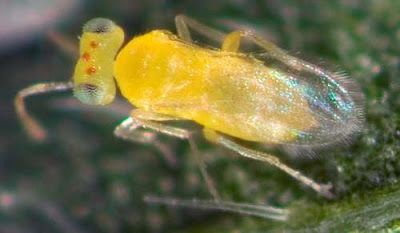
-Eretmocerus eremicus: This is another parasitic wasp, family very close to the previous one, used in greenhouses or indoor crops.
The adult wasp will be in charge of infesting the larvae of the whitefly.
In Pevgrow you will find out Eretmocerus eremicus in formats perfectly adapted to cannabis cropping. Our technical team will solve any doubt you may have regarding it.
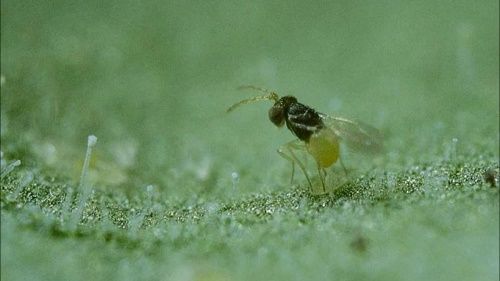
-Encarsia formosa: belongs to the Aphelinidae family, is another type of parasitic wasp for the treatment of whitefly. The females are black and about 6 mm and the males, which are very scarce, are also black and somewhat longer. The uses of this kind of organism date back from the beginning of the 20th century, although for some years its use has been professionalized and extended to other fields, such as marijuana professional horticulture.
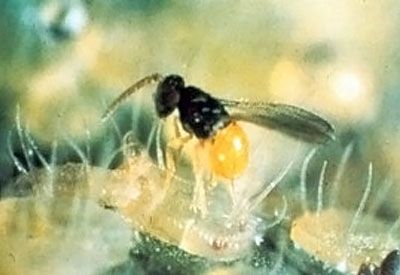
2-Entomopathogens:
The best known are Bacillus thuringiensis and Steinernema feltiae nematodes.
Bacillus is a bacteria which secretes a toxin that makes the pest organism to stop feeding and therefore to reproduce. There are many subspecies of Bacillus thuringiensis being the most common Kurstakii strain. It acts against a multitude of marijuana-eating caterpillars and thrips.
In case of steinerma nematodes, an infestation of larvae occurs in the pest organism, feeding on the content of this.
3-Predators:
Usually they are insects and mites that hunt and cause death to the living organisms that invade our crop.
Although is not usual, one of the problems that could lead to misuse of this type of insect or mite is that, in the absence of food, usually the insects can sometimes eat part of the plant.
The best known are currently:
-Ambliseius swirskii: Predatory mite to combat whitefly or thrips.
-Orius laevigatus: Predator bug for some species of thrips.
In Pevgrow we propose Thripor-L product based on these organisms.
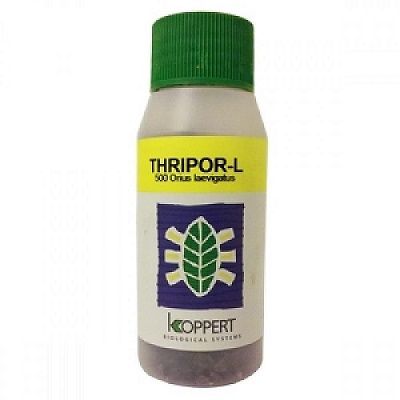
-Phytoseiulus persimilis: For the specific control of red spider pests. We recommend Spidex, a product provided from the same brand as product mentioned before.
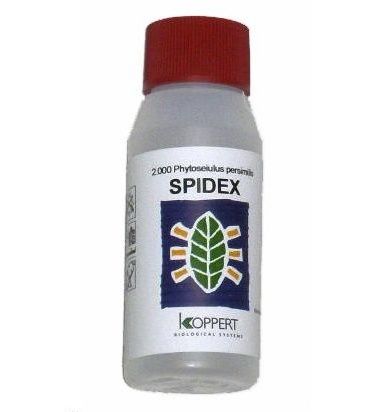
In some cases, marijuana growers often use entomopathogens, with some predators. If you are thinking of doing it that way, you will have to take into account in advance that they are not incompatible and, finally, could not lead you to the expected result.
Biological control against red spider
This type of pest is one of the most common in marijuana crops, especially when the climate is dry and hot. It is really dangerous, because what this invasive spider does is suck the sap of the plant, leaving its leaves yellow and causing death slowly to the plant, if not remedy.
How will you notice that? Because leaves begin to have yellow dots, a sign of chlorophyll losses.
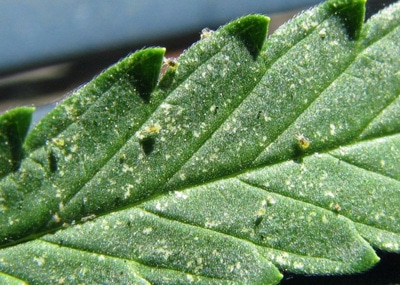
In general, as mentioned above, the type of predator that is used in these cases to control red spider pests is the Phytoseiulus persimilis mite. This mite is responsible for eating both eggs or larvae, as well as adult red spiders. They do it at a reasonable speed, which is the most interesting. In fact, it is estimated that the mite Phytoseiulus persimilis can eat an average of 20 eggs or larvae per day and about 5 adults. Not bad, right?
If it’s your case, here you have what products you can use: Spidex and Swirskimite.
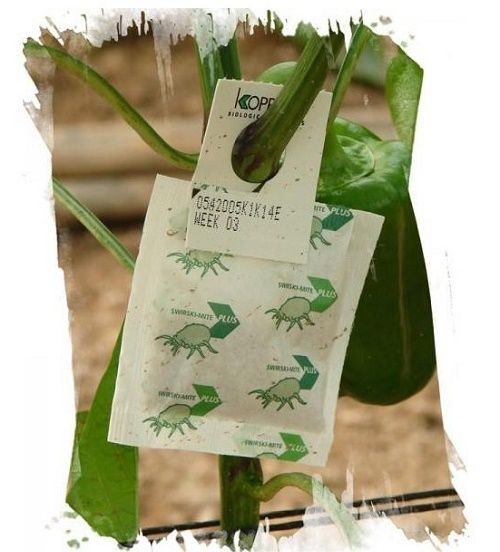
Biological fight against thrips
This type of small insects, with fringed wings, are yellow or gray and elongated giving rise to larvae that move a lot and do so very early. When a thrip plague invade a marijuana crop what they really do is to suck the cells of the superficial tissues, showing a grayish aspect giving rise to black points in the back side of the leaves of the plant, which are nothing else than their excrements. Really disgusting.
Another of the mites or predators that are used in the biological control against thrips and whiteflies are the Amblyseius californicus, which usually lay eggs for 14 days, and are able to eat an average of 5 adult thrips per day, plus some eggs or Larvae.
With a 20-day life as an adult individual, they are usually used when we can have doubts about a possible invasion of thrips or when they are not easy to detect.
In order to control this type of pests, in case of biological control against thrips, the Amblyseius cucumeris, a type of beige-colored predatory mite that perforates thrips and empties them completely, is normally used. This type of predator is also used to combat red spider pests.
Bedbugs, in particular, Orius laevigatus, already described above, is another of the most voracious predators against thrips, especially if we want to end up with adults.
Biological fight against white fly
Like red spider, the whitefly is another of these species that invade a large percentage of crops. As in the case of red spider, both larvae and adults suck the sap of the plant and, in doing so, they release a kind of molasses, leaving spots on the leaves and buds. Although are not as destructive as red spider, they prevent proper plant development, and therefore prevent us from obtaining a perfectly clean final product for human consumption.
And what can we do to avoid that? Normaly we can use the wasp Encarsia Formosa, starting to release as soon as we see the first whiteflies surrounding the crop space. This will be much more effective.
It is a very economical and cost-effective method.
In Pevgrow we have the product Ercal, that contains females and adult males of this organism ready to devour whiteflies.
Biological control against aphids
One of the biggest problems caused by aphids is that the invasion of this type of insects is a matter of few days, because they reproduce very fast. So in this case, more than in any case, it is essential that we act as quickly as possible.
In addition, they are the cause of black fungi appearance in cannabis plant and also make marijuana plant more susceptible to host certain viruses. Be aware of that!
How do we control this plague? It is usually used the little flies Aphidoletes aphidimyza, which are in charge to look for colonies of aphids. Their own larvae end up with aphids. It is estimated that the female can lay about 100 eggs in her fertile life, always looking for large nests of aphids to infest. Hence, it is ideal for pest control.
What do we propose? We recommend the use of the product Aphidend 2000, which contains the mosquito mentioned above.
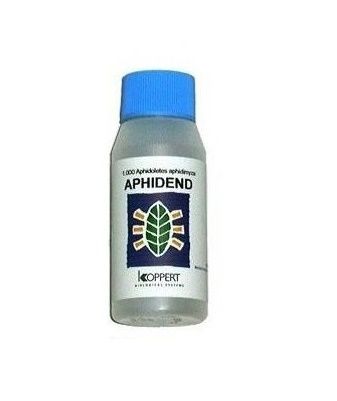
Their action is favoured by a climate especially humid with a night temperature around 16 degrees, conditions in which the males of this type of mosquito act.
How do you know if they have worked? Because aphids that have killed the larvae will be hung from the leaves, becoming brown colored, to finally fall from the leaves.
Biological control against other insect pests
In addition to those techniques mentioned, other common pests in marijuana plants can occur, although less common we can find out the following:
-Caterpillars: Although some years ago, caterpillars were common in summer or in October, these pests currenlty occur at any time of the year.
How to control these pests? Bacillus Thuringiensis is most commonly used. In this regard, we propose to use the product Bacillus Devorator, which is presented in the form of a dissolvable powder, so that its use is simply. This product does not modify the taste or aroma of cannabis plant.
-Cottony cushion: They affect mainly outdoor crops and they do it by sucking the sap of the plant. They also leave molasses in their path, which facilitate the appearance of pathogenic fungi. In this case we recommend the use of Chrysoperla carnea, which is an insect that treats very effectively the pests of thrips, cottony cushion, whitefly and aphids.
-Fungus Gnats: Although, in theory, they are not dangerous to your plants, nor for the people, the presence of fungus gnats can cause damages in cuttings and seedlings, as well as being indicative of other problems, such as overwatering, fungal proliferation or putrefaction.
To combat this type of pests it is commonly used a mite called hypoaspis mile, which is responsible for consuming flies larvae from the soil, as well as thrips, among other insects. It is very active in temperatures above 10 degrees.
Also it is used the organism Steinernema feltiae, belonging to the family of entomopathogens, does not cause any kind of harmful effect in our plants, and help us to control this type of pest. This organism is very active between 15 and 20 degrees.
In Pevgrow we recommend the use of Entonem product.
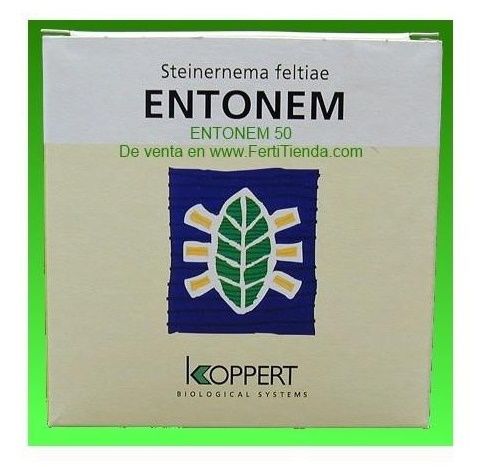
In summary
As we said at the beginning, prevention is better than regret and now you can discern what are the main plagues or the most common, as well as the methods to control or treat them biologically, using predators that end up with the invader plagues.
Of course, before doing so, remember these following 6 steps:
- Identify the pest that affects the crop.
- Estimate the extent and stage of the pest.
- Acquire the appropriate predators that can combat them.
- Ensure that our predator is not incompatible with other biological control predators that we want to use in our crop.
- Monitor that they perform their function correctly.
Have you applied any of these techniques? Do you know others that can be also effective?
We’d love to hear from you, come on! Leave me a comment at the bottom and I promise to answer you 😉
And if you liked the article, share it on social networks, THANKS!
By Noelia Jiménez, Team PevGrow






What about ladybugs
recipe for ratio of garlic, vinegar, water? Thanks!
Hello Julie,
I’ll publish it shortly, thank you for the suggestion.
How about a mix of water garlic and vinigar to prevent these bugs from eating and living on these plants?
Hi Joe,
It’s also a good remedy, thank you for your input.
It’s also a good home remedy, good luck buddy.